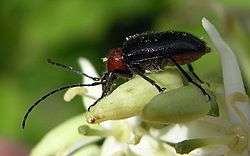Dinoptera collaris
Dinoptera collaris is the species of the Lepturinae subfamily in long-horned beetle family.[1]
| Dinoptera collaris | |
|---|---|
| Dinoptera collaris | |
| Scientific classification | |
| Kingdom: | |
| Phylum: | |
| Class: | |
| Order: | |
| Suborder: | |
| Superfamily: | |
| Family: | |
| Subfamily: | |
| Genus: | |
| Species: | D. collaris |
| Binomial name | |
| Dinoptera collaris (Linnaeus, 1758) | |
| Synonyms | |
| |
Subtaxa
There are four varietets in species:[1]
- Dinoptera collaris var. fulvohirsuta Hayrovsky
- Dinoptera collaris var. marginicollis Tippmann
- Dinoptera collaris var. nigricollis Mulsant
- Dinoptera collaris var. slamai Podaný, 1955
Distribution
Theses beetles are present in most of Europe and in the Near East (Albania, Austria, Belgium, Bulgaria, Croatia, Czech Republic, Denmark, France, Germany, Greece, Hungary, Iran, Italy, Luxembourg, Netherlands, Norway, Poland, Portugal, Romania, Russia, Serbia, Slovakia, Slovenia, Spain, Sweden, Switzerland, Syria, Turkey, and United Kingdom).[1][2]
Habitat
This species inhabit deciduous forests, especially beech forests and hedge rows.[3]
Description

Dinoptera collaris can reach a length of 6–9 millimetres (0.24–0.35 in).[3] Elytra are bluish-blackish and rather hairy, with dense puncture. Pronotum is almost spherical, usually orange-red, sometimes dark, with sparse punctuation. Antennae are quite long. The abdomen is orange-red.[4][5]
This species is rather similar to Acmaeops marginatus, Acmaeops pratensis and Acmaeops septentrionis.
Biology
The life cycle lasts two years. The larvae develop under the loose bark, especially of oaks, aspens or apple trees. They are polyphagous wood borers in deciduous trees (Quercus, Pyrus, Acer, Fraxinus, Populus, Malus, Cornus etc.) [4][3] They overwinter and pupate the following spring.[5]
The adult beetles can be found from April to August feeding on pollen of valerians (Valeriana species), common hawthorn (Crataegus monogyna), elderberry (Sambucus species), sweet chestnut (Castanea sativa) and European pear (Pyrus communis).[1][6]
References
- BioLib Taxon profile — species Dinoptera collaris (Linnaeus, 1758)
- Fauna europaea
- Commanster
- Cerambycidae
- Svatopluk Bílý,O. Mehl Longhorn Beetles - Coleoptera, Cerambycidae - Of Fennoscandia and Denmark
- Jiři Zahradnik, Irmgard Jung, Dieter Jung et al.: Käfer Mittel- und Nordwesteuropas, Parey Berlin 1985, ISBN 3-490-27118-1